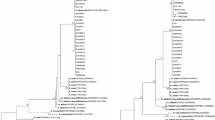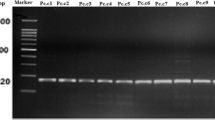Abstract
Suspected Dickeya sp. strains were obtained from potato plants and tubers collected from commercial plots. The disease was observed on crops of various cultivars grown from seed tubers imported from the Netherlands during the spring seasons of 2004–2006, with disease incidence of 2–30% (10% in average). In addition to typical wilting symptoms on the foliage, in cases of severe infection, progeny tubers were rotten in the soil. Six strains were characterised by biochemical, serological and PCR-amplification. All tests verified the strains as Dickeya sp. The rep-PCR and the biochemical assays showed that the strains isolated from blackleg diseased plants in Israel were very similar, if not identical to strains isolated from Dutch seed potatoes, suggesting that the infection in Israel originated from the Dutch seed. The strains were distantly related to D. dianthicola strains, typically found in potatoes in Western Europe, and were similar to biovar 3 D. dadanti or D. zeae. This is the first time that the presence of biovar 3 strains in potato in the Netherlands is described. One of the strains was used for pathogenicity assays on potato cvs Nicola and Mondial. Symptoms appeared 2 to 3 days after stem inoculation, and 7 to 10 days after soil inoculation. The control plants treated with water, or plants inoculated with Pectobacterium carotovorum, did not develop any symptoms with either method of inoculation. The identity of Dickeya sp. and P. carotovorum re-isolated from inoculated plants was confirmed by PCR and ELISA.





Similar content being viewed by others
References
Andújar, E., Flores, R., Morera, B., Ortega, M. G., & Montes, F. (2004). Problemática fitosanitaria de la patata temprana en Andalucía Occidental: II Bacterias. XII Congreso de la Sociedad Española de Fitopatología (SEF). Lloret de Mar (Gerona), Spain: 104 (Abstract).
Ayers, S. H., Rupp, P., & Johnson, W. T. (1919). A study of the alkali-forming bacteria in milk. United States Department of Agriculture Bulletin, 782, 1–39.
Cother, E. J. (1980). Bacterial seed tuber decay in irrigated sandy soils of New South Wales. Potato Research, 23, 75–79. doi:10.1007/BF02364027.
Cother, E. J., Bradley, J. K., Gillings, M. R., & Fahy, P. C. (1992). Characterization of Erwinia chrysanthemi biovars in alpine water sources by biochemical properties, GLC fatty acid analysis and genomic DNA fingerprinting. The Journal of Applied Bacteriology, 73, 99–107.
Cother, E. J., & Powell, V. (1983). Physiological and pathological characteristics of Erwinia chrysanthemi isolates from potato tubers. The Journal of Applied Bacteriology, 54, 37–43.
de Lindo, L., French, E. R., & Kelman, A. (1978). Erwinia spp. pathogenic to potatoes in Peru. American Potato Journal, 55, 383 Abstract.
Dickey, R. S. (1979). Erwinia chrysanthemi: a comparative study of phenotypic properties of strains from several hosts and other Erwinia species. Phytopathology, 69, 324–329.
Dye, D. W. (1969). A taxonomic study on the genus Erwinia: II. the “carotovora” group. New Zealand Journal of Science, 12, 81–97.
Frechon, D., Exbrayat, P., Helias, V., Hyman, L. J., Jouan, B., Llop, P., Lopez, M. M., Payet, N., Perombelon, M. C. M., Toth, I. K., Van Beckhoven, J. R. C. M., Van der Wolf, J. M. and Bertheau, Y. (1998). Evaluation of a PCR kit for the detection of Erwinia carotovora subsp. atroseptica on potato tubers. Potato Research, 41, 163–173.
Hyman, L. J., Toth, I. K., & Perombelon, M. C. M. (1998). Isolation and identification. In M. C. M. Perombelon & J. M. van der Wolf (Eds.), Methods for detection and quantification of Erwinia carotovora subsp. atroseptica on potatoes: A laboratory manual. Occasional Publication No. 10 (pp. 60–65). Dundee, UK: Scottish Crop Research Institute.
Janse, J. D., & Spit, B. E. (1989). A note on the limitations of identifying soft rot erwinias by temperature tolerances and sensitivity to erythromycin on a pectate medium. Journal of Phytopathology, 125, 265–268. doi:10.1111/j.1439-0434.1989.tb01068.x.
Joutsjoki, T., Laurila, J., Pirhonen, M., Lehtinen, A., & Hannukkala, A. (2005). Diagnostics and incidence of black keg caused by Erwinia bacteria in Finland. Proceedings of the 16th Triennial Conference of the EAPR. Bilbao, Spain: 717–718.
Lumb, V. M., Pérombelon, M. C. M., & Zutra, D. (1986). Studies of a wilt disease of the potato plant in Israel caused by Erwinia chrysanthemi. Plant Pathology, 35, 196–202. doi:10.1111/j.1365-3059.1986.tb02004.x.
Moeller, V. (1955). Manuel des Techniques Bacteriologiques. In: R. Buttiaux, H. Beerens, & H. Tacquet (Eds.) (pp. 302). Paris: Flamma-rion.
Nassar, A., Darrasse, A., Lemattre, M., Kotoujansky, A., Dervin, C., Vedel, R., et al. (1996). Characterization of Erwinia chrysanthemi by pectinolytic isozyme polymorphism and restriction fragment length polymorphism analysis of PCR-amplified fragments of pel genes. Applied and Environmental Microbiology, 62, 2228–2235.
Palacio-Bielsa, A., Cambra, M. A., & Lopez, M. M. (2006). Characterization of potato isolates of Dickeya chrysanthemi in Spain by a microtitre system for biovar determination. The Annals of Applied Biology, 148, 157–164. doi:10.1111/j.1744-7348.2006.00045.x.
Pérombelon, M. C. M. (2002). Potato diseases caused by soft rot erwinias: an overview of pathogenesis. Plant Pathology, 51, 1–12. doi:10.1046/j.0032-0862.2001.Short title.doc.x.
Pérombelon, M. C. M., & Hyman, L. J. (1986). A rapid method for identifying and quantifying soft rot erwinias directly from plant material based on their temperature tolerance and sensitivity to erythromycin. The Journal of Applied Bacteriology, 60, 61–66.
Pérombelon, M. C. M., & van der Wolf, J. M. (1998). Methods for the detection and quantification of Erwinia carotovora subsp. atroseptica on potatoes. Dundee, UK: SCRI Publications No 10.
Rademaker, J. L. W., Louws, F. J., & de Bruijn, F. J. (1997). Characterization of the diversity ef ecologically important microbes by rep-PCR genomic fingerprinting. Molecular Microbial Ecology Manual.
Samson, R., Legendre, J. B., Christen, R., Achouak, W., & Gardan, L. (2005). Transfer of Pectobacterium chrysanthemi (Brenner et al. 1973) and Brenneria paradisiaca (Hauben et al. 1998) to the genus Dickeya gen. nov. as Dickeya chrysanthemi comb. nov. and Dickeya paradisiaca comb. nov. and delineation of four novel species: Dickeya dadantii sp. nov., Dickeya dianthicola sp. nov., Dickeya dieffenbachiae sp. nov. and Dickeya zeae sp. nov. International Journal of Systematic and Evolutionary Microbiology, 55, 1415–1427. doi:10.1099/ijs.0.02791-0.
Serfontein, S., Logan, C., Swanepoel, A. E., Boelema, B. H., & Theron, D. J. (1991). A potato wilt disease in South Africa caused by Erwinia carotovora subspecies carotovora and E. chrysanthemi. Plant Pathology, 40, 382–386. doi:10.1111/j.1365-3059.1991.tb02394.x.
Tanii, A., & Baba, T. (1971). Bacterial plant diseases in Hokkaido II. Bacterial stem rot of potato plant caused by Erwinia chrysanthemi (Burkholder et al.) (Pectobacterium carotovora var. chrysanthemi). Bulletin of the Hokkaido Prefectural Agricultural Experimental Station, 24, 1–10.
Toth, I. K., Avrova, A. O., & Hyman, L. J. (2001). Rapid identification and differentiation of the soft rot Erwinias by 16S-23S intergenic transcribed spacer-PCR and restriction fragment length polymorphism analyses. Applied and Environmental Microbiology, 67, 4070–4076. doi:10.1128/AEM.67.9.4070-4076.2001.
Tsror (Lahkim), L., Aharon, M., & Erlich, O. (1999). A survey of bacterial and fungal seedborne diseases in imported and domestic potato seed tubers. Phytoparasitica, 27, 215–226.
Tsror (Lahkim), L., Erlich, O., Lebiush, S., Zig, U., & van de Haar, J. J. (2006). Recent outbreak of Erwinia chrysanthemi in Israel—epidemiology and monitoring in seed tubers. In: Proceedings of the 11th International conference on Plant Pathogenic Bacteria. Edinburgh, pp. 70–71.
Versalovic, J., Koeuth, T., & Lupski, J. R. (1991). Distribution of repetitive DNA sequences in eubacteria and application to fingerprinting of bacterial genomes. Nucleic Acids Research, 19, 6823–6831. doi:10.1093/nar/19.24.6823.
Acknowledgements
We thank the officers of the Plant Protection Israeli Services (PPIS) for providing the data of disease incidence in the commercial fields, and C. Weinstein for editing the manuscript. The research was partially supported by The Plant Production and Marketing Board, Israel.
Author information
Authors and Affiliations
Corresponding author
Rights and permissions
About this article
Cite this article
Tsror (Lahkim), L., Erlich, O., Lebiush, S. et al. Assessment of recent outbreaks of Dickeya sp. (syn. Erwinia chrysanthemi) slow wilt in potato crops in Israel. Eur J Plant Pathol 123, 311–320 (2009). https://doi.org/10.1007/s10658-008-9368-0
Received:
Accepted:
Published:
Issue Date:
DOI: https://doi.org/10.1007/s10658-008-9368-0




